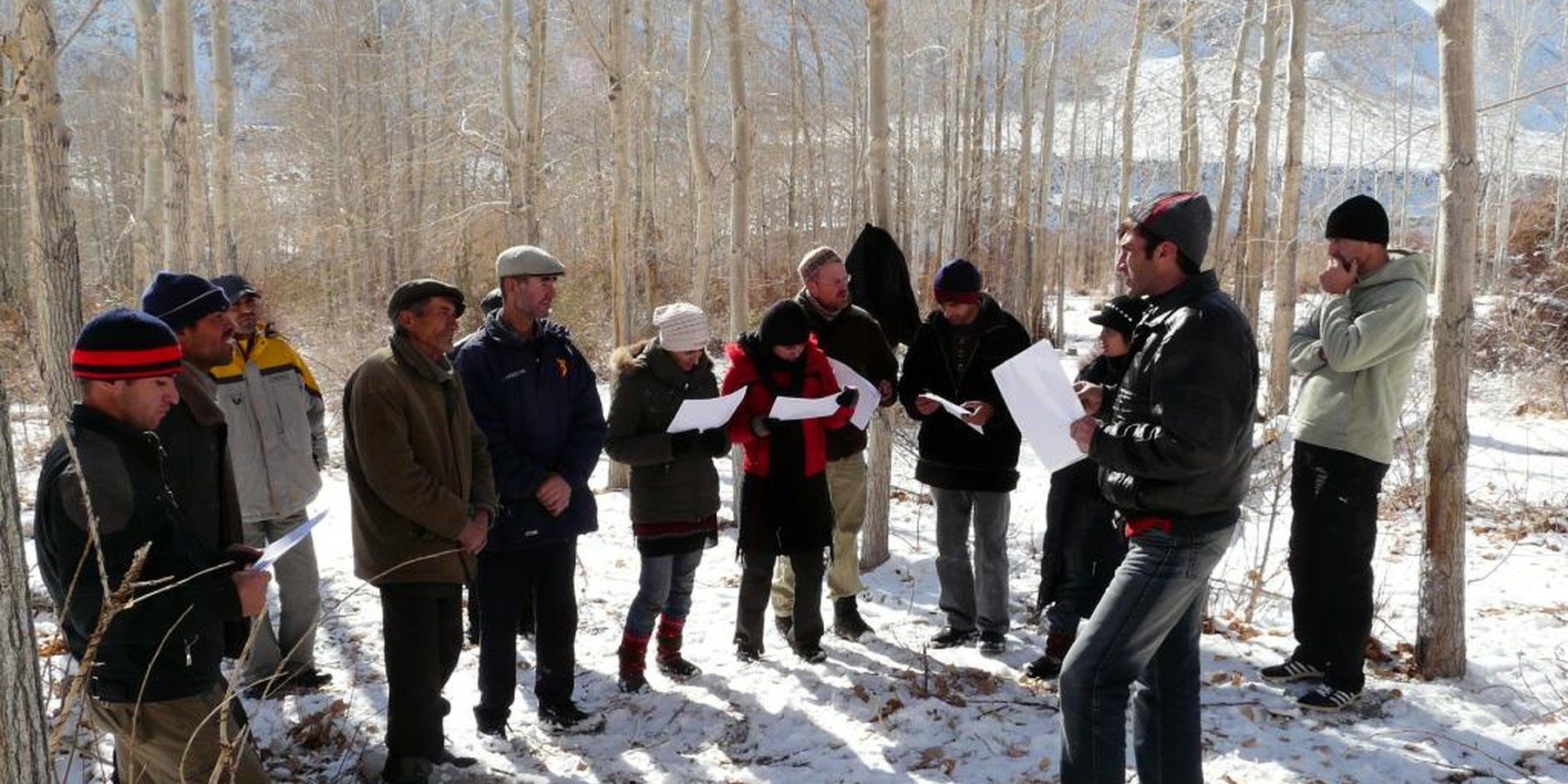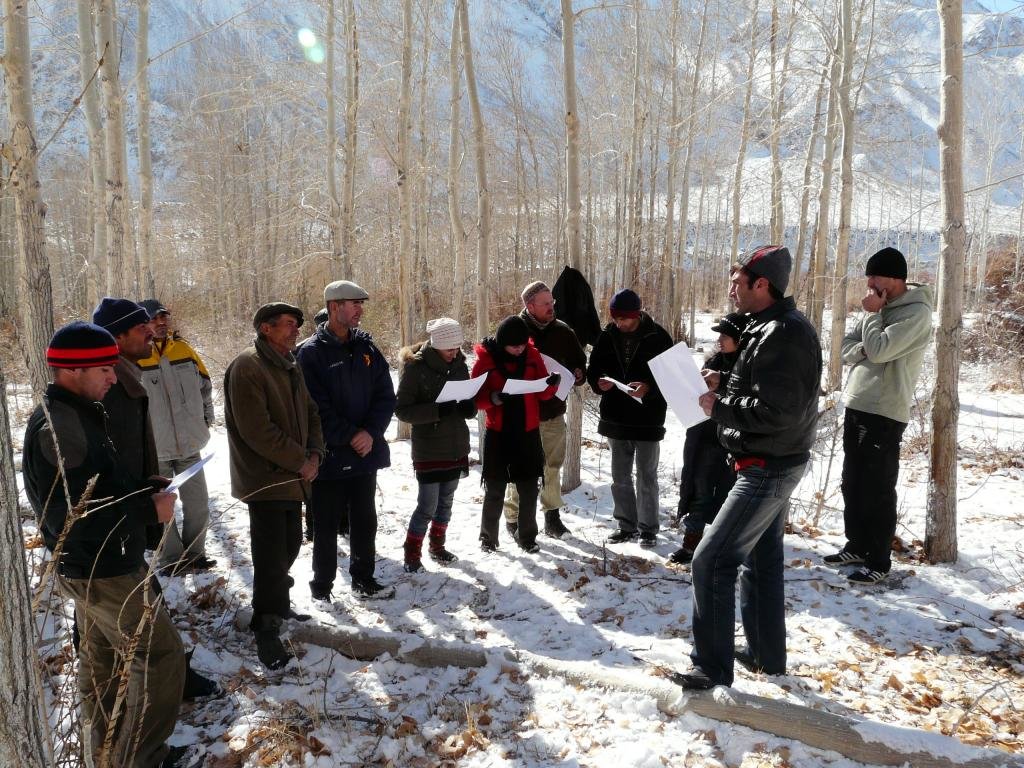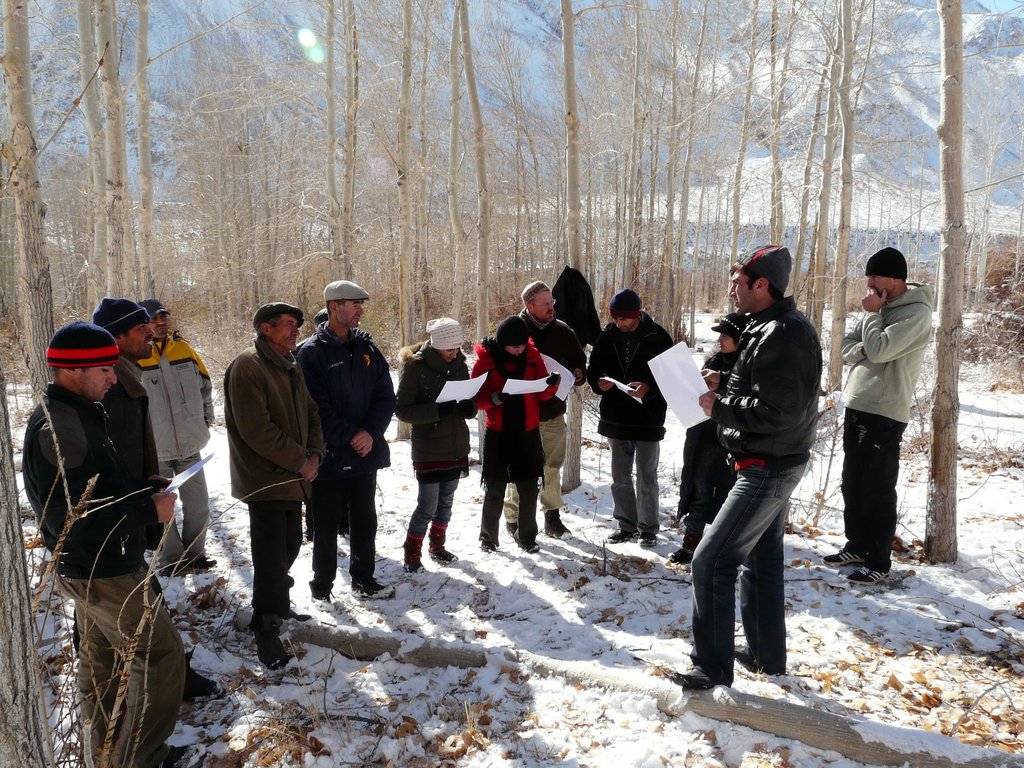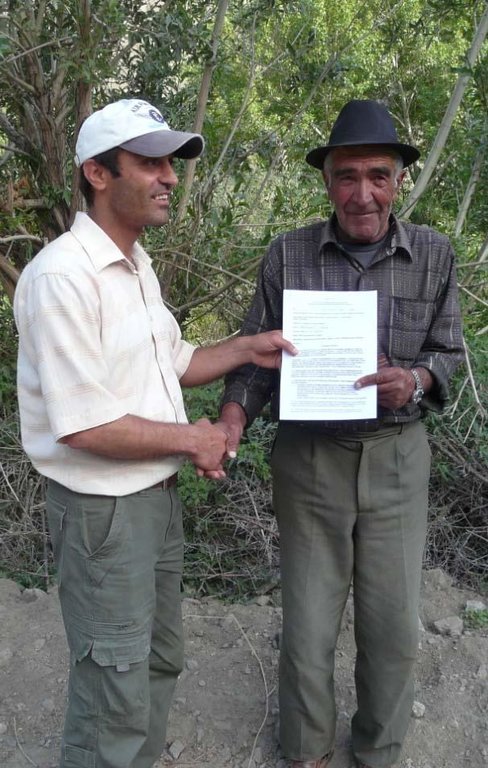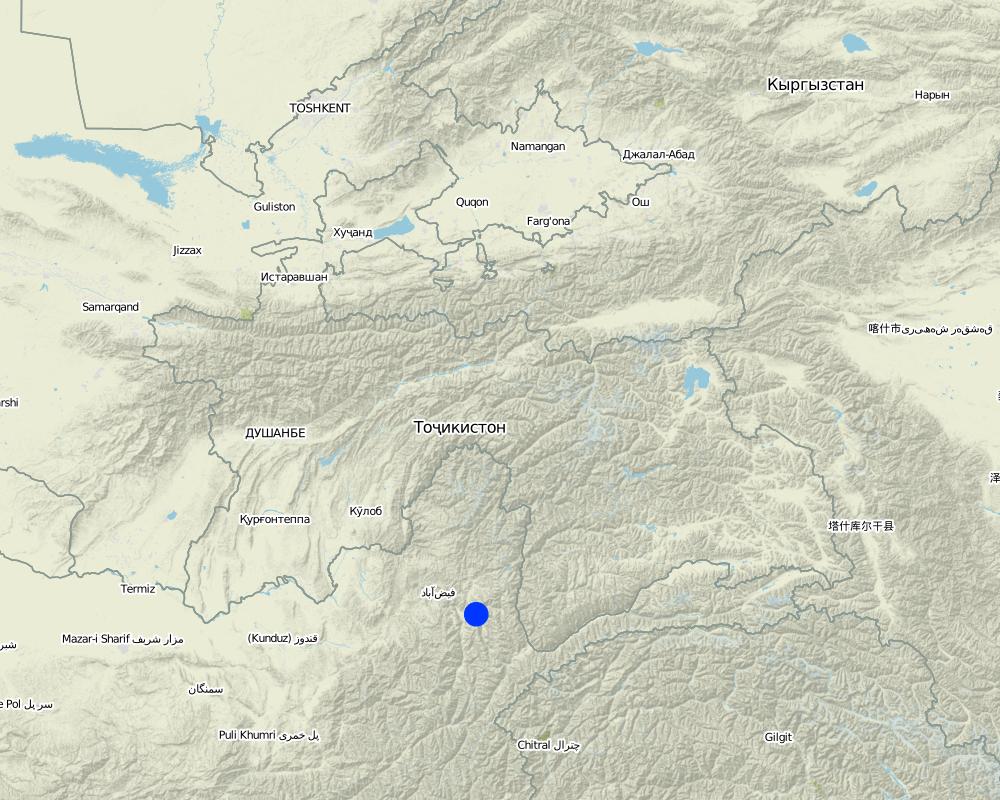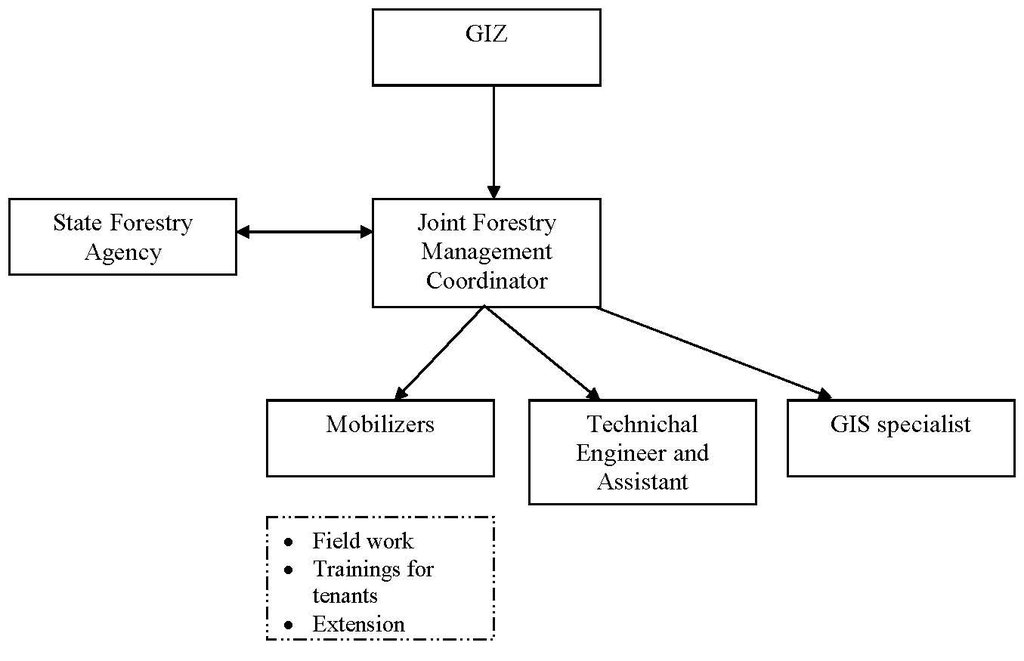Joint Forest Management (JFM) [Tajikistan]
- Creation:
- Update:
- Compiler: Roziya Kirgizbekova
- Editor: –
- Reviewer: David Streiff
Совместное управление лесами (СУЛ) (Russian)
approaches_2431 - Tajikistan
View sections
Expand all Collapse all1. General information
1.2 Contact details of resource persons and institutions involved in the assessment and documentation of the Approach
SLM specialist:
SLM specialist:
Angermann Michael
+992 935 747318
michael.angermann@giz.de
GIZ, Sustainable Management of Natural Resources in Gorno-Badakhshan
Okhonjon Str. 58-1, 736000 Khorog, Tajikistan
Germany
SLM specialist:
Neusel Benjamin
+992 935 747312
benjamin.neusel@cimonline.de
GIZ, Sustainable Management of Natural Resources in Gorno-Badakhshan
Okhonjon Str. 58-1, 736000 Khorog, Tajikistan
Germany
SLM specialist:
Kirchhoff Joachim F.
+992 44 6006702
joachim.kirchhoff@giz.de
GIZ, Regional Program on Sustainable Use of Natural Resources in Central Asia
Ayni Str./Nazarshoev Str., 734026 Dushanbe
Germany
Name of project which facilitated the documentation/ evaluation of the Approach (if relevant)
Central Asian Countries Initiative for Land Management (CACILM I)Name of the institution(s) which facilitated the documentation/ evaluation of the Approach (if relevant)
Deutsche Gesellschaft für Internationale Zusammenarbeit (GIZ) GmbH (GIZ) - Germany1.3 Conditions regarding the use of data documented through WOCAT
When were the data compiled (in the field)?
23/08/2009
The compiler and key resource person(s) accept the conditions regarding the use of data documented through WOCAT:
Yes
1.4 Reference(s) to Questionnaire(s) on SLM Technologies
2. Description of the SLM Approach
2.1 Short description of the Approach
Protection and rehabilitation of state forests based on joint long term agreements set up between the State Forestry Agency, and local forest users (in the frame of CACILM).
2.2 Detailed description of the Approach
Detailed description of the Approach:
Aims / objectives: In Soviet times, the Gorno Badakhshan Autonomous Region (GBAO) had been highly dependent on subsidised fuel for heating and cooking. After independence, as fuel could no longer be imported from the former Soviet Union, more pressure was exerted on the flood plain forests, leading to severe degradation of the resources through illegal felling and livestock grazing. The State Forestry Agency does not have the financial means nor adequate capacity to implement a sustainable forestry management system adapted to the changed political, socio-economic and ecological conditions. The main aim of this approach is the rehabilitation of degraded floodplain forests in collaboration with the local users. This can only be achieved, if local users can see that they will benefit from conserving and developing the forest. Also, the State Forestry Agency is supported in its restructuring and gets an opportunity to achieve the protection of the forest, and economic goals through forest products and income from the rented forest plots.
Methods: \'Joint Forest Management\' (JFM) means that governmental organisations and local users are involved in forest management on the basis of a contract with a duration of 20 years, valid under Tajik law, which defines the rights and obligations of all the parties. As a first step, and in order to ensure the protection of the plot, a fence has to be built to protect reforestation activities from livestock (see Technology TAJ366). Adequate irrigation of the forest areas is also supported. Forest tenants as well as Forestry Agency staff are also trained in sustainable forest management techniques. Progresses and challenges are regularly being monitored and technical advice is being given to forest tenants.
Stages of implementation: The implementation includes eight steps: (1) field check and meeting with village representatives, (2) information workshop, (3) general agreement with the whole community, (4) selection of tenants, (5) division of the plots, (6) signing of contracts with the individual tenants, (7) elaboration of management plans and annual plans for each tenant, and (8) monitoring of annual plans.
Role of stakeholders: The annual plan is based on a 5-year management plan for the respective plot. It determines the amount of work undertaken by the forest tenant as well as harvests and their shares to be obtained from the rented area in one year. The rental contract, the management plan, and the annual plan are mutually agreed on by the forest tenants and the Forestry Agency. Forest tenants develop a sense of ownership and responsibility for the sustainable use of forests and forest resources on their plot. The State Forestry Agency is responsible for control and technical advice.
2.3 Photos of the Approach
2.5 Country/ region/ locations where the Approach has been applied
Country:
Tajikistan
Region/ State/ Province:
Tajikistan Gorno Badakhshan Autonomous Region (GBAO)
Further specification of location:
Ishkashim, Roshtkala, Shugnan
Comments:
This approach is currently implemented in the districts of Shugnan, Roshtkala and Ishkashim in GBAO, and each year, the area covered is gradually increasing.
Map
×2.6 Dates of initiation and termination of the Approach
Indicate year of initiation:
2009
2.7 Type of Approach
- project/ programme based
2.8 Main aims/ objectives of the Approach
The Approach focused mainly on SLM with other activities (Income generation, income diversification, forest rehabilitation, improved access to forest resources)
Protection and rehabilitation of state forests based on joint long term agreements set up between the State Forestry Agency, and local forest users.
The SLM Approach addressed the following problems: Limited management and control capacities of the State Forestry Agency, combined with a sudden increasing need for firewood resulted in an uncontrolled 'open access' situation in the floodplain forests of GBAO. People were using forest resources in an unsustainable manner, including uncontrolled felling and livestock pasture. This resulted in a large scale degradation of the floodplain forest resources.
2.9 Conditions enabling or hindering implementation of the Technology/ Technologies applied under the Approach
availability/ access to financial resources and services
- hindering
No funds available for the rehabilitation of irrigation infrastructure.
Treatment through the SLM Approach: Initial set up investments co-financed by international NGOs (GIZ).
institutional setting
- hindering
No organisational structures for overall local management of rented state forests in place, including conflict solving mechanisms between stakeholders from different administrative levels.
Treatment through the SLM Approach: Establishment of Joint Forest Management council at local level.
legal framework (land tenure, land and water use rights)
- hindering
User rights for state forest were exclusively with the State Forestry Agency. Locals used the forests illegally.
Treatment through the SLM Approach: Contracts with individual tenants providing them with long-term user rights and responsibilities.
The existing land ownership, land use rights / water rights greatly hindered the approach implementation The forest land is in State property, the State Forestry Agency has exclusive user rights, however open access leads to uncontrolled use of forest resources by the local people. Restricting access can help create clear regulations, but these are not always accepted by villagers who prefer illegal open access to natural resources.
workload, availability of manpower
- hindering
After the collapse of the Soviet Union, the Forestry Agency had insufficient financial and human resources to manage the state forests.
Treatment through the SLM Approach: Responsibilities and workload are shared with the local population.
other
- hindering
The State Forestry Agency lacks finances and capabilities to manage forest resources.
Treatment through the SLM Approach: Support of the Agency for internal reforms and the introduction of a sustainable forest management scheme (JFM).
3. Participation and roles of stakeholders involved
3.1 Stakeholders involved in the Approach and their roles
- local land users/ local communities
Women and men, rich and poor are involved equally
Actual implementation in close cooperation with the other bodies
- SLM specialists/ agricultural advisers
GIZ project staff and forest specialists
Supporting local users in implementing the Technology with some modifications.
The Approach has been designed by an international specialist, and some components by a local specialist
Conducting workshops, providing technical advice
- NGO
International non-government
Coordination and financing of the project, design of the approach
- local government
Support during implementation
Cooperation, approval of the legal framework
- national government (planners, decision-makers)
Support during implementation
Cooperation, approval of the legal framework
If several stakeholders were involved, indicate lead agency:
GIZ
3.2 Involvement of local land users/ local communities in the different phases of the Approach
| Involvement of local land users/ local communities | Specify who was involved and describe activities | |
|---|---|---|
| initiation/ motivation | interactive | Field visits, talks with village representatives, information seminar for the whole community. |
| planning | interactive | 5-year Management Plans and 1-year Annual Plans are developed for each forest plot, jointly by the land users and State Forestry Agency staff. |
| implementation | interactive | Live fence construction, irrigation rehabilitation, sharing of harvest. |
| monitoring/ evaluation | interactive | Completed via the close cooperation between the State Forestry Agency and GIZ, using interviews completed by project mobilisers, as well as monitoring of annual achievements. |
| Research | none |
3.3 Flow chart (if available)
Description:
Organisational chart shows how the project staff work with the State Forestry Agency.
Author:
Sady Odinashoev (Tajikistan, Dushanbe)
3.4 Decision-making on the selection of SLM Technology/ Technologies
Specify who decided on the selection of the Technology/ Technologies to be implemented:
- mainly SLM specialists, following consultation with land users
Explain:
The approach was developed and implemented in other geographical settings (South Asia) and adapted to the local conditions in GBAO. It is continuously being adapted, according to the practical experiences of SLM specialists and through consultation with the local forest tenants.
Decisions on the method of implementing the SLM Technology were made by mainly by land users supported by SLM specialists. GIZ project staff and forest specialists supported local users in implementing the Technology with some modifications.
4. Technical support, capacity building, and knowledge management
4.1 Capacity building/ training
Was training provided to land users/ other stakeholders?
Yes
Specify who was trained:
- land users
- field staff/ advisers
If relevant, specify gender, age, status, ethnicity, etc.
At first, so called 'community mobilisers' were trained, who further provided training for forest users.
Form of training:
- on-the-job
- demonstration areas
- public meetings
- courses
Subjects covered:
Sustainable natural resources management, technical forestry knowledge (planting, thinning) and elaboration of management plans.
4.2 Advisory service
Do land users have access to an advisory service?
Yes
Specify whether advisory service is provided:
- on land users' fields
Describe/ comments:
Forestry training for tenants and forestry staff; Key elements: Sustainable natural resource management and use, Technical training in forestry management (planting and harvesting, fencing etc.)
Advisory service is quite adequate to ensure the continuation of land conservation activities; Government saw the good results gained from the Joint Forest Management approach, and is interested in continuing this approach.
4.3 Institution strengthening (organizational development)
Have institutions been established or strengthened through the Approach?
- yes, greatly
Specify the level(s) at which institutions have been strengthened or established:
- local
Specify type of support:
- financial
- capacity building/ training
Give further details:
The State Forestry Agencie's building was renovated and computers were provided for the Agency. Mobilisers were trained to conduct advisory services. Transport for field works was provided. The State Forestry Agency is being supported in its restructuring towards becoming a sustainable institution
4.4 Monitoring and evaluation
Is monitoring and evaluation part of the Approach?
Yes
Comments:
Area treated aspects were regular monitored by project staff through observations; indicators: GIS and data base systems were established
No. of land users involved aspects were ad hoc monitored by project staff, government through observations; indicators: based on the number of contracts, registered in data base
area treated aspects were regular monitored by project staff, government, land users through measurements; indicators: GIS and data base systems were established
bio-physical aspects were regular monitored by project staff, government through observations; indicators: annual monitoring (autumn)
no. of land users involved aspects were ad hoc monitored by project staff, government, land users through measurements; indicators: based on the number of contracts
management of Approach aspects were regular monitored by None through observations; indicators: regular planning, reporting and evaluation
There were several changes in the Approach as a result of monitoring and evaluation: Regular adaptation of the approach after evaluation and analysis of field work results and occurring challenges.
There were no changes in the Technology as a result of monitoring and evaluation: None
4.5 Research
Was research part of the Approach?
No
5. Financing and external material support
5.1 Annual budget for the SLM component of the Approach
If precise annual budget is not known, indicate range:
- 10,000-100,000
Comments (e.g. main sources of funding/ major donors):
Approach costs were met by the following donors: local community / land user(s) (Implementation of measures in the forest are covered by land users): 10.0%; government (Provision of areas for JFM implementation, support of implementation): 10.0%; international (Full project organisation: meetings, workshops, technical advice): 80.0%
5.2 Financial/ material support provided to land users
Did land users receive financial/ material support for implementing the Technology/ Technologies?
No
5.3 Subsidies for specific inputs (including labour)
- equipment
| Specify which inputs were subsidised | To which extent | Specify subsidies |
|---|---|---|
| machinery | fully financed | Excavator |
- infrastructure
| Specify which inputs were subsidised | To which extent | Specify subsidies |
|---|---|---|
| Irrigation infrastructure | fully financed | Rehabilitation of some irrigation infrastructure |
If labour by land users was a substantial input, was it:
- rewarded with other material support
Comments:
Also voluntary labour was an important input
5.5 Other incentives or instruments
Were other incentives or instruments used to promote implementation of SLM Technologies?
Yes
If yes, specify:
The State Forestry Agencie's building was renovated and computers were provided for the Agency. Mobilisers were trained to conduct advisory services. Transport for field works was provided. The State Forestry Agency is being supported in its restructuring towards becoming a sustainable institution
6. Impact analysis and concluding statements
6.1 Impacts of the Approach
Did the Approach help land users to implement and maintain SLM Technologies?
- No
- Yes, little
- Yes, moderately
- Yes, greatly
The vegetation cover of the forest plots under JFM was improved through better protection and planting. No open access to forests was allowed, which prevents illegal and uncontrolled use of forest resources.
Did the Approach improve issues of land tenure/ user rights that hindered implementation of SLM Technologies?
- No
- Yes, little
- Yes, moderately
- Yes, greatly
User rights are clearly assigned according to the law of the Republic of Tajikistan. Tenants and local people developed a sense of ownership and responsibility for the sustainable use of forests and forest resources.
Did other land users / projects adopt the Approach?
- No
- Yes, little
- Yes, moderately
- Yes, greatly
Did the Approach lead to improved livelihoods / human well-being?
- No
- Yes, little
- Yes, moderately
- Yes, greatly
As a result of better protection and rehabilitation, people can legally sell the surplus of harvested firewood, non-timber forest products etc., which adds to their family's income.
Did the Approach help to alleviate poverty?
- No
- Yes, little
- Yes, moderately
- Yes, greatly
Good sites allow for immediate sale and own consumption of fire wood and non-timber forest products. Heavily degraded sites will produce income in about 5 years after rehabilitation and maintenance.
6.2 Main motivation of land users to implement SLM
- increased production
Firewood
- rules and regulations (fines)/ enforcement
Contract based legal access to forest
- well-being and livelihoods improvement
Possibility to have revenues from selling forest products (and products for own consumption)
6.3 Sustainability of Approach activities
Can the land users sustain what has been implemented through the Approach (without external support)?
- yes
If yes, describe how:
Much interest among the land users as they have now legal access to the forest.
6.4 Strengths/ advantages of the Approach
| Strengths/ advantages/ opportunities in the land user’s view |
|---|
| Trusting Forestry Agency (How to sustain/ enhance this strength: Follow the rules established in the contracts and management plans.) |
| Benefit through legal access to forest products (firewood, construction, wood, fruits, etc) |
| Strengths/ advantages/ opportunities in the compiler’s or other key resource person’s view |
|---|
| Improved forest protection and management (How to sustain/ enhance this strength: Forest users have a sense of ownership and responsibility for the sustainable use of forests and forest resources. Close collaboration of the Forestry Agency with the forest tenants will be crucial.) |
| Benefit through legal access to forest products (firewood, construction, wood, fruits. etc) (How to sustain/ enhance this strength: Contract guarantees user rights for 20 years. Good management assured through regular advice and monitoring by the Forestry Agency (twice a year in spring and autumn).) |
6.5 Weaknesses/ disadvantages of the Approach and ways of overcoming them
| Weaknesses/ disadvantages/ risks in the land user’s view | How can they be overcome? |
|---|---|
| At the beginning of the project, benefits seen to be gained from the forest are not high (especially wood) | Planting of fast growing bushes and trees, perennial, fodder crops. |
| Weaknesses/ disadvantages/ risks in the compiler’s or other key resource person’s view | How can they be overcome? |
|---|---|
| At the initial stage, financing of the approach without project (INGO) support is difficult | In the future, by increasing the productivity of the forest areas, more finances can possibly be made available to forest users and the forestry department. |
7. References and links
7.1 Methods/ sources of information
- field visits, field surveys
- interviews with land users
7.2 References to available publications
Title, author, year, ISBN:
Forestry Sector Analysis of the Republic of Tajikistan, Joachim F. Kirchhoff and André Fabian, 2010
Available from where? Costs?
Contact: jochim.kirchhoff@giz.de or michael.angermann@giz.de
Links and modules
Expand all Collapse allLinks
No links
Modules
No modules


